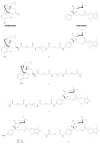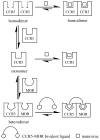A Bivalent Ligand Targeting the Putative Mu Opioid Receptor and Chemokine Receptor CCR5 Heterodimers: Binding Affinity versus Functional Activities
- PMID: 23682308
- PMCID: PMC3652433
- DOI: 10.1039/C3MD00080J
A Bivalent Ligand Targeting the Putative Mu Opioid Receptor and Chemokine Receptor CCR5 Heterodimers: Binding Affinity versus Functional Activities
Abstract
Opioid substitution and antiretroviral therapies have steadily increased the life spans of AIDS patients with opioid addiction, while the adverse drug-drug interactions and persistence of HIV-associated neurocognitive disorders still require new strategies to target opioid abuse and HIV-1 comorbidities. A bivalent ligand 1 with a 21-atom spacer was thus synthesized and explicitly characterized as a novel pharmacological probe to study the underlying mechanism of opioid-enhanced NeuroAIDS. The steric hindrance generated from the spacer affected the binding affinity and Ca2+ flux inhibition function activity of bivalent ligand 1 at the chemokine receptor CCR5 more profoundly than it did at the mu opioid receptor (MOR). However, the CCR5 radioligand binding affinity and the Ca2+ flux inhibition function of the ligand seemed not necessarily to correlate with its antiviral activity given that it was at least two times more potent than maraviroc alone in reducing Tat expression upon HIV-1 infection in human astrocytes. Furthermore, the ligand was also about two times more potent than the simple mixture of maraviroc and naltrexone in the same viral entry inhibition assay. Therefore bivalent ligand 1 seemed to function more effectively by targeting specifically the putative MOR-CCR5 heterodimer in the viral invasion process. The results reported here suggest that a properly designed bivalent ligand may serve as a useful chemical probe to study the potential MOR-CCR5 interaction during the progression of NeuroAIDS.
Keywords: CCR5; MOR; NeuroAIDS; bivalent ligand; functional selectivity.
Figures



Similar articles
-
Exploration of bivalent ligands targeting putative mu opioid receptor and chemokine receptor CCR5 dimerization.Bioorg Med Chem. 2016 Nov 15;24(22):5969-5987. doi: 10.1016/j.bmc.2016.09.059. Epub 2016 Sep 26. Bioorg Med Chem. 2016. PMID: 27720326 Free PMC article.
-
Design and synthesis of a bivalent ligand to explore the putative heterodimerization of the mu opioid receptor and the chemokine receptor CCR5.Org Biomol Chem. 2012 Apr 7;10(13):2633-46. doi: 10.1039/c2ob06801j. Epub 2012 Feb 22. Org Biomol Chem. 2012. PMID: 22354464 Free PMC article.
-
Structure-Based Design and Development of Chemical Probes Targeting Putative MOR-CCR5 Heterodimers to Inhibit Opioid Exacerbated HIV-1 Infectivity.J Med Chem. 2021 Jun 10;64(11):7702-7723. doi: 10.1021/acs.jmedchem.1c00408. Epub 2021 May 23. J Med Chem. 2021. PMID: 34027668 Free PMC article.
-
Ligand-Free Signaling of G-Protein-Coupled Receptors: Relevance to μ Opioid Receptors in Analgesia and Addiction.Molecules. 2022 Sep 8;27(18):5826. doi: 10.3390/molecules27185826. Molecules. 2022. PMID: 36144565 Free PMC article. Review.
-
Maraviroc: a CCR5-receptor antagonist for the treatment of HIV-1 infection.Clin Ther. 2008 Jul;30(7):1228-50. doi: 10.1016/s0149-2918(08)80048-3. Clin Ther. 2008. PMID: 18691983 Review.
Cited by
-
Molecular signatures of mu opioid receptor and somatostatin receptor 2 in pancreatic cancer.Mol Biol Cell. 2016 Nov 7;27(22):3659-3672. doi: 10.1091/mbc.E16-06-0427. Epub 2016 Sep 28. Mol Biol Cell. 2016. PMID: 27682590 Free PMC article.
-
Design, syntheses, and pharmacological characterization of 17-cyclopropylmethyl-3,14β-dihydroxy-4,5α-epoxy-6α-(isoquinoline-3'-carboxamido)morphinan analogues as opioid receptor ligands.Bioorg Med Chem. 2015 Apr 15;23(8):1701-15. doi: 10.1016/j.bmc.2015.02.055. Epub 2015 Mar 6. Bioorg Med Chem. 2015. PMID: 25783191 Free PMC article.
-
Detection of Receptor Heteromerization Using In Situ Proximity Ligation Assay.Curr Protoc Pharmacol. 2016 Dec 13;75:2.16.1-2.16.31. doi: 10.1002/cpph.15. Curr Protoc Pharmacol. 2016. PMID: 27960030 Free PMC article.
-
Synthesis and interest in medicinal chemistry of β-phenylalanine derivatives (β-PAD): an update (2010-2022).Future Med Chem. 2024;16(11):1147-1162. doi: 10.1080/17568919.2024.2347063. Epub 2024 May 9. Future Med Chem. 2024. PMID: 38722231 Free PMC article. Review.
-
Exploration of bivalent ligands targeting putative mu opioid receptor and chemokine receptor CCR5 dimerization.Bioorg Med Chem. 2016 Nov 15;24(22):5969-5987. doi: 10.1016/j.bmc.2016.09.059. Epub 2016 Sep 26. Bioorg Med Chem. 2016. PMID: 27720326 Free PMC article.
References
-
- National Institute of Drug Abuse. [Accessed on May 12, 2012];DrugFacts: HIV/AIDS and Drug Abuse: Intertwined Epidemics. http://www.drugabuse.gov/publications/drugfacts/hivaids-drug-abuse-inter....
-
- Mathers BM, Degenhardt L, Phillips B, Wiessing L, Hickman M, Strathdee SA, Wodak A, Panda S, Tyndall M, Toufik A, Mattick RP. Lancet. 2008;372:1733–1745. - PubMed
-
- Chang SL, Vigorito M. Am J Infect Dis. 2006;2:98–106.
-
- United Nations Office on Drugs and Crime. [Accessed on May 12, 2012];World Drug Report. 2011 http://www.unodc.org/unodc/en/data-and-analysis/WDR-2011.html.
Grants and funding
LinkOut - more resources
Full Text Sources
Other Literature Sources
Chemical Information
Research Materials
Miscellaneous

